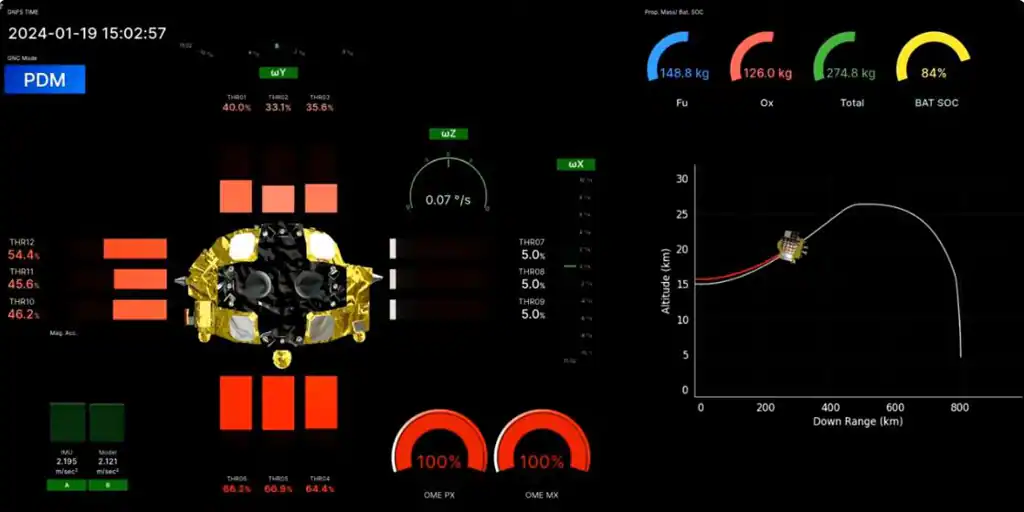Japan lands on the moon for the first time, but the ship can’t generate power

The Smart Lander for Investigating Moon (SLIM) managed to land on the moon’s south pole this afternoon, making Japan the fifth country to achieve this feat after the United States, Soviet Union, China and India. But the Japanese’s joy was dampened soon after their space agency JAXA confirmed that the lander’s solar panels could not generate power. This problem confirms the difficulties of successfully reaching our natural satellite. Japan itself has had two failed missions in the past, and hours earlier Astrobotic’s US Peregrine Falcon disintegrated in a controlled manner over the Pacific Ocean after a failed journey to the Moon.
The SLIM mission, launched last September from Tanegashima Island, entered lunar orbit in December last year. From then on, it took pictures of the surface and slowly descended in preparation for landing. The final descent finally began this afternoon at 16:00 (Spanish Peninsula time) at a speed of about 1,700 meters per second. The craft landed on the Moon in 20 minutes, a time described as “terrible” due to its extreme difficulty. Once on the ground, he reestablished contact with Earth, but his solar panels were unable to generate electricity, possibly because they were positioned at the wrong angle. “SLIM now runs solely on its battery, and we are prioritizing transmitting its data to Earth,” said Hitoshi Kuninaka, head of JAXA’s space laboratory.
Sniper
The big novelty of the Japanese mission was the search for unprecedented precision in landing on the Moon, which earned the ship the nickname “Moon Sniper.” The module was to land within a hundred meters of the target, in an irregularly shaped rocky crater called Theophilus south of the lunar equator, much narrower than the usual landing zones of several kilometers. To do this, during descent, the module had to compare its onboard cameras with data from other spacecraft orbiting the Moon. However, it will take a month to know whether the mission achieved the desired accuracy or landed further from its target.
JAXA has landed on small asteroids twice, but it’s not the same as landing on the Moon, whose gravity won’t allow it to stop for another try. SLIM, a sort of box measuring 2.4 x 1.7 x 2.7 m and weighing 700 kg, includes two main engines with 12 motors surrounded by solar panels, antennas, radar and cameras. Keeping it lightweight was another goal of the design, as Japan intends to fly more frequent missions in the future by reducing launch costs.
at the south pole
As India first did last August with its low-cost space program, the Japanese mission also landed at the moon’s south pole, very little explored but of great interest due to the likely presence of frozen water, a valuable resource. for the future construction of human colonies. In addition, the agency hoped to gain access to the moon’s mantle, the inner layer beneath its crust, and gain new information about the origins of the Earth and its moon.
If all goes according to plan, the module will release a pair of innovative rovers that will travel the lunar surface. The microwave-sized Lunar Excursion Vehicle 1 (LEV-1) is designed to hop, rather than crawl on wheels like traditional rovers. The LEV-2, on the other hand, is an attractive metal sphere, slightly larger than a tennis ball, designed by toy company Takara Tomy to roll around on the ground and take photos.
Two failures
More than 50 years after humans reached the Moon, many countries and private companies are trying to make their share there. But many end up with ships crashing on the satellite, experiencing communication failures or other technical problems. The last attempt to fail was that of Peregrine, a private mission promoted by NASA, which burned up over the Pacific Ocean this Thursday during a controlled re-entry into the Earth’s atmosphere. A few hours after launch, the ship suffered a fuel leak, which made landing on the Moon impossible. NASA has shelved plans to send manned missions to the Moon as part of its Artemis program.
Japan itself has had two failed missions in its history: one public and one private. In 2022, the island country failed to send the Omotenashi lunar probe. In April, startup ispace attempted to become the first private firm to reach the Moon, but lost contact with its spacecraft after a “hard landing.”